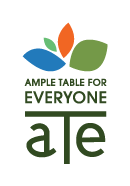Eating a nutritionally sound diet should be the goal of every one of us. But with diet-related diseases, including cardiovascular disease, diabetes, high blood pressure and some cancers affecting more than half of the US population, it’s clear many of us don’t have a clue what that means, or where to begin.
Add pregnancy to this scenario.
Two of the most common attitudes around eating during pregnancy are: 1) I’m going to gain weight anyway, so I might as well take advantage of these nine months and eat whatever I want. Or on the flip side, 2) I don’t want to gain any more than the baby’s weight. Neither of these approaches is healthy for pregnant mother or baby. A mother’s diet has long-reaching consequences.
In the six years ATE has awarded grants to support our food insecure neighbors in New York City, we have come to recognize the critical importance of maternal nutrition during pregnancy. But, there are many challenges–homelessness, low wages, language barriers, insufficiently stocked local markets, and lack of time or education around basic nutrition principles.
While ATE and many other civic and private social service organizations as well as private foundations work to address some of these challenges for long-term change, there is abundant and useful online information readily available on good nutrition and nutrition during pregnancy. We hope you will share this information with those who may not know where to turn for guidance.
Fresh versus frozen: how to choose
For starters, let’s bust the myth that fresh vegetables and fruits are healthier than frozen ones. In terms of nutrition, frozen vegetables and fruits (look for those without sauces and no added sugar!) offer benefits for busy households, or during the months when fresh produce is not available, or in areas of New York City referred to as “food deserts.”
Online resources
A valuable resource in learning and planning for “nutritionally sound” eating is the USDA (United States Department of Agriculture) website. Start with the five food groups that make up MyPlate: fruits, vegetables, grains, protein and dairy and explore from there. Know someone who is Spanish-speaking or only speaks Chinese? Information on the website exists in many languages—from Arabic to Urdu!
The website offers practical tips on shopping within a budget, planning meals, recipes and more. The methods for delivering information include graphics, videos and clear text, all available in a range of languages. Exploring the ChooseMyPlate website you will find recipes; information on SNAP; and recommendations for eating well during pregnancy. Some women may find they qualify for supplemental financial and/or food assistance via the WIC program.
What every pregnant woman should know… and eat.
Another helpful resource emphasizing the critical nutrition needs during pregnancy is the American College of Obstetrics and Gynecology. The general website offers excellent information on pregnancy with a link to specific recommendations on nutrition.
Just as preparation for a marathon requires a runner to adjust her nutritional needs, pregnancy also makes specific nutritional demands on a woman’s body. The National Institutes of Health is another useful online resource. Vitamin and mineral needs specific to pregnancy are addressed in this article.
Following is a list of essential nutrients, recommended whether you are planning to breastfeed or not.
- Folic acid
- Vitamin D
- Iron
- Iodine
- Calcium
- DHA
In sum: Be proactive!
If you are pregnant (or know someone who is), detailed nutrition information and recommendations on specific foods and menus should be part of your care. If you are not getting that information from the prenatal clinic or private obstetrician overseeing your pregnancy, take advantage of the user-friendly online resources mentioned above. Often, the medical focus (and it is an essential one) is on avoiding and/or addressing problems during pregnancy—e.g. blood pressure and weight gain/loss and ultrasounds to evaluate the growth of the fetus. Equally important is informing yourself or seeking out a certified nutritionist to make the pregnancy a positive and healthy experience.
For many women, pregnancy is a moment to “make things right,” especially eating habits for themselves. Seeking out healthy foods during pregnancy can carry over into making positive decisions about food on an ongoing basis. Pregnancy is a time to be pro-active!
March is National Nutrition Month. To learn more about this and other topics pertaining to feeding food insecure New Yorkers, or to get involved, please visit Ample Table for Everyone and join our communities on Facebook or Twitter.

